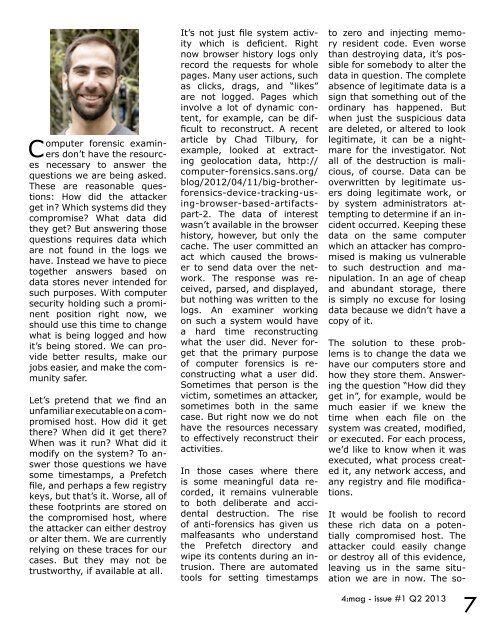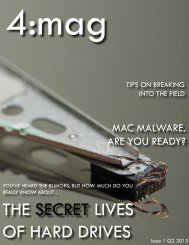Create successful ePaper yourself
Turn your PDF publications into a flip-book with our unique Google optimized e-Paper software.
Computer forensic examiners<br />
don’t have the resources<br />
necessary to answer the<br />
questions we are being asked.<br />
These are reasonable questions:<br />
How did the attacker<br />
get in? Which systems did they<br />
compromise? What data did<br />
they get? But answering those<br />
questions requires data which<br />
are not found in the logs we<br />
have. Instead we have to piece<br />
together answers based on<br />
data stores never intended for<br />
such purposes. With computer<br />
security holding such a prominent<br />
position right now, we<br />
should use this time to change<br />
what is being logged and how<br />
it’s being stored. We can provide<br />
better results, make our<br />
jobs easier, and make the community<br />
safer.<br />
Let’s pretend that we find an<br />
unfamiliar executable on a compromised<br />
host. How did it get<br />
there? When did it get there?<br />
When was it run? What did it<br />
modify on the system? To answer<br />
those questions we have<br />
some timestamps, a Prefetch<br />
file, and perhaps a few registry<br />
keys, but that’s it. Worse, all of<br />
these footprints are stored on<br />
the compromised host, where<br />
the attacker can either destroy<br />
or alter them. We are currently<br />
relying on these traces for our<br />
cases. But they may not be<br />
trustworthy, if available at all.<br />
It’s not just file system activity<br />
which is deficient. Right<br />
now browser history logs only<br />
record the requests for whole<br />
pages. Many user actions, such<br />
as clicks, drags, and “likes”<br />
are not logged. Pages which<br />
involve a lot of dynamic content,<br />
for example, can be difficult<br />
to reconstruct. A recent<br />
article by Chad Tilbury, for<br />
example, looked at extracting<br />
geolocation data, http://<br />
computer-forensics.sans.org/<br />
blog/2012/04/11/big-brotherforensics-device-tracking-using-browser-based-artifactspart-2.<br />
The data of interest<br />
wasn’t available in the browser<br />
history, however, but only the<br />
cache. The user committed an<br />
act which caused the browser<br />
to send data over the network.<br />
The response was received,<br />
parsed, and displayed,<br />
but nothing was written to the<br />
logs. An examiner working<br />
on such a system would have<br />
a hard time reconstructing<br />
what the user did. Never forget<br />
that the primary purpose<br />
of computer forensics is reconstructing<br />
what a user did.<br />
Sometimes that person is the<br />
victim, sometimes an attacker,<br />
sometimes both in the same<br />
case. But right now we do not<br />
have the resources necessary<br />
to effectively reconstruct their<br />
activities.<br />
In those cases where there<br />
is some meaningful data recorded,<br />
it remains vulnerable<br />
to both deliberate and accidental<br />
destruction. The rise<br />
of anti-forensics has given us<br />
malfeasants who understand<br />
the Prefetch directory and<br />
wipe its contents during an intrusion.<br />
There are automated<br />
tools for setting timestamps<br />
to zero and injecting memory<br />
resident code. Even worse<br />
than destroying data, it’s possible<br />
for somebody to alter the<br />
data in question. The complete<br />
absence of legitimate data is a<br />
sign that something out of the<br />
ordinary has happened. But<br />
when just the suspicious data<br />
are deleted, or altered to look<br />
legitimate, it can be a nightmare<br />
for the investigator. Not<br />
all of the destruction is malicious,<br />
of course. Data can be<br />
overwritten by legitimate users<br />
doing legitimate work, or<br />
by system administrators attempting<br />
to determine if an incident<br />
occurred. Keeping these<br />
data on the same computer<br />
which an attacker has compromised<br />
is making us vulnerable<br />
to such destruction and manipulation.<br />
In an age of cheap<br />
and abundant storage, there<br />
is simply no excuse for losing<br />
data because we didn’t have a<br />
copy of it.<br />
The solution to these problems<br />
is to change the data we<br />
have our computers store and<br />
how they store them. Answering<br />
the question “How did they<br />
get in”, for example, would be<br />
much easier if we knew the<br />
time when each file on the<br />
system was created, modified,<br />
or executed. For each process,<br />
we’d like to know when it was<br />
executed, what process created<br />
it, any network access, and<br />
any registry and file modifications.<br />
It would be foolish to record<br />
these rich data on a potentially<br />
compromised host. The<br />
attacker could easily change<br />
or destroy all of this evidence,<br />
leaving us in the same situation<br />
we are in now. The so-<br />
4:<strong>mag</strong> - issue <strong>#1</strong> <strong>Q2</strong> <strong>2013</strong><br />
7




